The migrant community building active citizenship in no man’s land
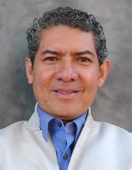 Elmer Romero
Elmer Romero
Neighborhood Centers Inc.
United States of America
Abstract – This is a story about the difficulties facing the migrant community in the United States and the potential of active citizen participation by migrants. How organisations and people work in education with the transformation of the traditional system of education into active learning that promotes critical thinking is also shown. Finally, a methodological approach which aims to create citizen transformers of reality is presented.
Let us take a closer look at Gulfton, a community in Southwest Houston, Texas. Approximately 70% of the students in this community are Latino, 10% are African American, 8% are Asian and Pacific Islander, respectively, and 2% are Native American.
A total of 56,256 people have used the services provided by the Baker Ripley community centres. Nearly 5,000 people have been part of adult education, enrichment and community development programmes.
To understand what it takes to help migrants become active citizens, it is important to know the reality in which the migrant community lives.
The migrant community has its own set of economic activities. Women are mainly engaged in the preparation of food in restaurants, cleaning and maintenance, care of children and in the tourist service. Men work mainly in construction, land- scaping, maintenance of homes, cooking, painting, activities in the oil industry and as subcontractors for small companies.
Most migrants send money back home to their country of origin through remittances, intended for consumption and to support their families. A smaller percentage invest in properties and the development of their own business, preparing for the future or as an alternative life on their return home from the United States.
Learning to live together
This community is a result of the migratory flows that have developed in recent decades. It is an area with great cultural diversity; 70 nationalities coexist and try to become citizens. A majority of migrants come from Mexico and Central America. Mexico has a long history of migrants who have settled in Houston as a city offering better job opportunities and a lower cost of living compared to other cities in the country. Central American migrants came here to escape wars in Central America during the 70s and 80s. The most recent migrants in this group have increasingly come due to violence by gangs and drug traffickers, a lack of employment opportunities and social exclusion. This forces them to seek a better quality of life and a more promising future for their families.
The levels of organisation in the migrant community are highly embryonic. Most migrants do not belong to solid organisational structures. However, there are also some migrants who are part of several organisations. Other migrants are again linked to national organisations; these associations represent the migrant community and provide them with an identity. Two such organisations are for example Mexicanos sin Fronteras (Mexicans without Borders) and Salvadoreños del Mundo (Salvadorans of the World).
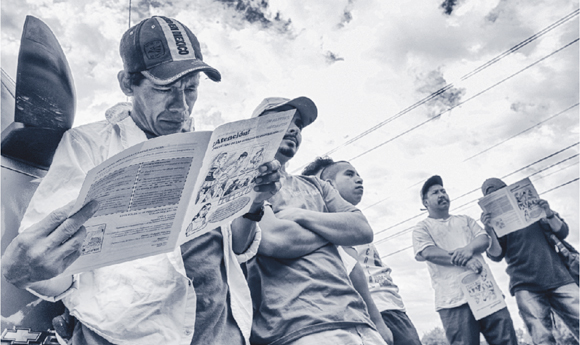
Day-labourers on a corner get informed through popular education material on how to protect themselves against immigration raids. Silver Spring, Maryland, © Elmer Romero
Always on the run
The biggest challenge for the migrant community is the lack of a legal immigrant status that allows them to feel safe, reunite their families, find better job oppor tunities and attain economic stability. The migrant population lives in the limbo of uncertainty. Its members are victims of abuse and of anti- immigration laws that criminalise them and have them constantly on the run. Members of the migrant community lack health insurance and access to quality health services. They have few options to learn English in order to facilitate communication, develop technical skills and cultural competences that would allow them better job opportunities. Migrants live in very deplorable conditions, in areas where there is vio lence, illicit groups of people and drug addiction.
“1 out of 5 adults living in this city in Texas are illiterate.”
Barbara Bush Houston Literacy Foundation 2014
Migrant women are victims of domestic and gender violence. There is a high percentage of single mothers who were victims of sexism, neglect and unwanted pregnancies. Most of these women did not complete basic education in their home countries. This implies the need for literacy and for the opportunity to complete primary and secondary education. 1 out of 5 adults living in this city in Texas are illiterate (Barbara Bush Houston Literacy Foundation 2014).
In their home countries these migrants were mainly peasants, manual workers and sweatshop workers and indigenous people, with some middle class sprinkled in. A percentage of the migrant community were involved in local development processes in their rural communities and the empowerment of citizens in villages and municipalities.
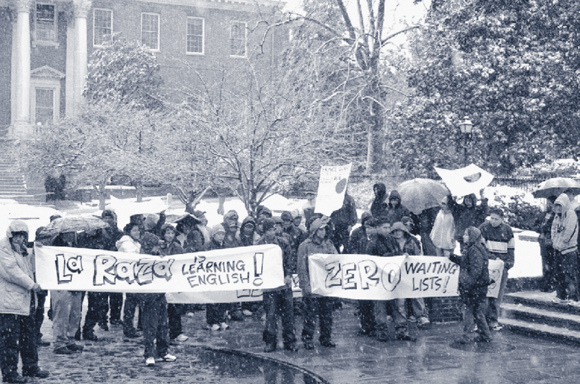
ESL (English as a Second Language) students participate in a day of lobbying and advocacy to demand more funding for adult education and reduce waiting lists. Annapolis, Maryland,
© Elmer Romero
Those formerly active people recognise that they were forced to migrate because the “development model” in their countries excluded them and left them without life opportunities. A par t of the migrant population comes from communities with an ecclesiastic base, with par ticipation in trade unions and with militant left-wing political parties. This group harbours a more complex analysis of the current development model, and they are very critical of the capitalist system and of neoliberal globalisation.
“If the migrant community organises itself, it can be the catalyst for future changes in the area of civil rights, defence and the struggle for human rights and active local and global empowerment.”
The appreciative method
Migrants are a constantly growing community at present. In this we see a great potential for [active] citizen participation. The migrant community is the cornerstone of the economic dynamics of the United States. It strengthens cultural diversity and has changed or is changing monolingualism in the United States. Spanish is the second most commonly spo ken language in the country. There is also great potential for organisation. There is a saying that undocumented immigrants are “a sleeping giant”. If the migrant community organises itself, it can be the catalyst for future changes in the area of civil rights, defence and the struggle for human rights and active local and global empowerment.
Our work focuses on the discovery of this human capacity in community development. The appreciative approach recognises that everyone has skills, talents and abilities. Communities where skills and values are used in the search for the common good will be stronger. By using the connection between individuals, the community and the institution, we are able to take the first steps towards transforming a community, and to start involving its citizens. Appreciative inquiry is based on in-depth dialogue and is focused on organisational change; it helps groups to evaluate the current situation of the community, envision what could be, and forge an innovative future (Watkins and Mohr 1991). Following the appreciative approach is an active citizenship-building perspective. According to this, “citizenship is learned through education, socialisation, being exposed and vulnerable to political, public life and day-to-day experiences. Promoting active citizenship among people who have been marginalised in politics is not a simple task. Citizenship does not simply arise naturally in response to an increase in the public sphere or political opportunities. Citizenship is more than voting or performing public duties. It is not only the selection of public servants using the system; citizenship entails building and shaping the structures of the system and its rules” (Veneklasen and Miller 2002).
Have passport, now what?
Currently what we have is a mass of “citizens” with American passports and credentials to vote, but without an awareness of what it means to exercise transformational citizenship. Government entities and some related community agencies have dedicated themselves to the work of pursuit and massive recruitment, encouraging those who qualif y to fill out applications and prepare them through pedagogical interventions and methodologies to learn the history and civics of their new country. These entities do not generate an active conscience, nor do they impart what it means to acquire new citizenship-based leadership. That is to say, an engaged citizenry committed to those marginal sectors which are excluded by the system.
Helping to foster active citizens is no easy task. For adult migrants in general, we have identified areas of training and citizen support in the issues of: migration, labour and human rights, financial education and economic literacy, literacy, English as a Second Language (ESL), primary and secondar y education, transition towards technical careers and university studies, leadership, community involvement, public policy and advocacy, activism, environment, community health, development of healthy eating habits and exercise, gender and women’s rights, technology and learning programmes using media tools in the workplace, general cognitive enrichment programmes, solidarity economy and small business development, entrepreneurship and craft practices, amongst other things. Obviously it is simpler and cheaper to teach history and civics, which may or may not be one reason for the very narrow understanding of citizenship on the part of government entities.
There can be no active citizen-building without developing critical thinking
First, it is important to note that the educational practices with migrant populations in the United States are generally imbued with current educational trends and experiences in the field of adult education from the traditional point of view. The education offered by community support centres and agencies that shelter immigrants in churches, consulates, libraries, county of fices and state and local government or support networks is eminently welfare-driven and top-down.
The educational processes are authoritarian and undemocratic (teachers command and migrants obey). There are no spaces offered for participation and dialogue; this is not conducive to the emergence of leadership. There is a methodological divorce between theory and practice, between manual labour (for poor and undocumented migrants) and intellectual labour (for migrants with more resources, permanent residence, new American citizens and people belonging to the second generation of migrants) and defi nitely between education and [active] citizenship. The current education system is verbalist and extremely bookish, and is unrelated to the work of community life, production and community development. There is a lack of educational practices in the areas of health, ecology, gender, organisation and production, technology, justice and democracy.

Participator y methodologies are implemented in adult education classes with immigrants and refugees to promote interactive learning and more energetic civil actions. Houston, Texas,
© Elmer Romero
A culture of dominance and control
There are no liberating teaching materials; there are countless teaching materials, but many of them have not been contextualised and updated. On the other hand, there is little knowledge of the cultural and rural reality of the migrant populations, their resources and potential, their socioeconomic aspects and the factors that determine them. There is limited access to positive educational materials supporting creativity and critical thinking. The curriculum contents are alien to the culture and being of the people, and they fail to help transform thinking or question what is unfair. The methodologies are inadequate, obsolete and induce boredom. They do not take account of the life of the migrant community or the participator y communication skills and leadership. One cause of this traditionalism in the educational process is that the teachers and instructors have been trained to be transmitters of knowledge, preservers of order and academic discipline and “reproducers” of the social system. Our educational practices in adult education programmes in the organisation are trying to reverse these bad practices and promote a new approach to working with our students. We want to bring to life what Jean Piaget said: “The main aim of education is to train people to be capable of doing new things, not simply repeating what other generations have done: people who are creative, who are inventive and are discoverers. The second goal of education is to form minds capable of exercising criticism, who can see for themselves what is presented to them and not simply accept without further thought” (Priestley 2004).
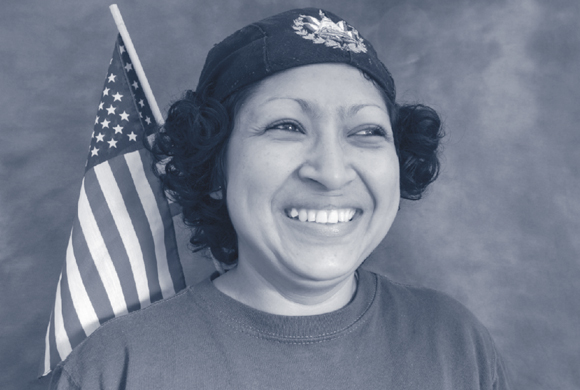
Day-labourer and domestic worker leaders exercising their civil rights in favour of better working conditions and access to other basic ser vices for the undocumented immigrant community. Silver Spring, Maryland, © Elmer Romero
Reclaiming Freire
There are many educational options, among them the legacy of Paulo Freire as expressed in the Pedagogy of the Oppressed. These alternatives provide the reference framework for the work towards the implementation and teaching of critical thinking. The contributions of Paulo Freire are a reference for our work with migrant populations struggling to meet their needs and rights in a society that excludes them. Although Freire was a widely-read and well-known educator in the United States, his legacy is hardly applied in the concrete and daily practices of educational efforts. The vast majority of teachers in the formal education system ignore the contributions of Freire at the educational level. To make matters worse, his practical teachings have been infected by an academicism which fails to promote critical thinking in students. As a result, we have an education system which grows more dangerous every day. Children and youth in schools are educated to individualism and competition. Schools compete among themselves to raise academic standards and submit their students to rigorous and suf focating discipline for the sole purpose of passing examinations so that those same schools can receive monetary rewards from the Government. The sons and daughters of immigrants are at a competitive disadvantage in this model because they have scarce emo tional and academic support due to the minimal involvement of their families and the lack of resources to support their learning.
A contribution that drives our work is the possibility of articulating a pedagogy for the movement of the day labourers in the United States with the pedagogical features of the Landless Movement in Brazil. Day labourers constitute a movement and a phenomenon with particular characteristics: They are a diverse workforce made up of migrant labourers from many countries of Latin America, the Caribbean, Africa and other par ts of the world. Street corners in large cities are the places where working relationships are established, and social interaction, entrepreneurship, education and organisation takes place. Day labourers contribute significantly to the US economy and to the economies of their countries of origin. Currently some of these day labourers have joined together to form the National Network of Day Labourers based in Los Angeles, California. They are led by Pablo Alvarado, a Salvadoran peasant leader who TIME magazine called the “new Cesar Chavez”.
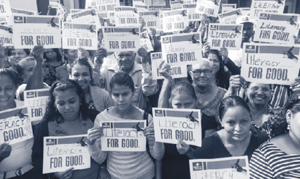
Adult education students raise their voices on International Literacy Day in order to boost awareness about this scourge and to reduce levels of illiteracy in the state of Texas. Houston, Texas, © Elmer Romero
The true colours of active citizenship
This movement is the main target of attack by xenophobic hate groups and organisations, as well as by anti-immigrant initiatives. In many cities the network is accused of a rise in crime, drug abuse and the use of county resources through funds received by non-profit organisations that support migrants. At educational and pedagogical level, the network has articulated an educational plan that includes several areas: ESOL (English for Speakers of Other Languages) for day labourers, literacy, community leadership, labour rights, community organisation, a tireless defence against the deportation of people, and approval of an integral and comprehensive immigration reform.
On its own initiative, the movement has developed a gender policy within its membership and is giving an impetus to a popular education methodology. It has integrated art and culture into its work to foster creative and playful work among its par ticipants so they can be more autonomous, critical and productive.
Our practices lead us to conclude that we want to promote the kind of citizenship dreamed of by the Panamanian educator Raul Leis: full, deep, emancipated, substantive, active, comprehensive, transformative and with a focus on gender. Although progress is visible every day, there are still many gaps to fill.
References
Barbara Bush Houston Literacy Foundation (2014): Houston’s Literacy Crisis: A Blueprint for Community Action.
Neighborhood Centers Inc. (2010): Descubriendo las Fortalezas de Nuestras Comunidades – Pasos para la Construcción Comunitaria. Houston: Neighborhood Centers Inc.
Priestley, M. (2004): Técnicas y Estrategias del Pensamiento Crítico. Mexico: Editorial Trillas.
Veneklasen, L. & Miller, V. (2002): Un Nuevo Tejido del Poder, los Pueblos y la Política – Guía de Acción para la Incidencia y la Participación Ciudadana. Oklahoma, USA: World Neighbors.
Watkins, J & Mohr, B. (1991): Appreciative Inquiry: Change at the Speed of Imagination. San Francisco: Jossey-Bass/Pfeiffer.
About the author
Elmer Romero is a practitioner of popular education and a communicator. He completed graduate studies in journalism, adult education and popular education. He worked in the Asociación Equipo Maíz (Maize Team Association) of El Salvador (www.equipomaiz.org.sv). Since 2001 he has been working in the United States in the fi eld of popular education with migrants and refugees in various states in the country. Currently he works for the organisation Neighborhood Centres Inc.
Contact
4215 University Blvd
Houston, Texas 77005
USA
elmerosalva@hotmail.com


